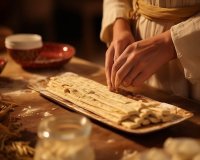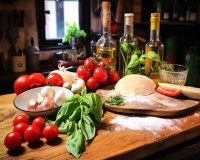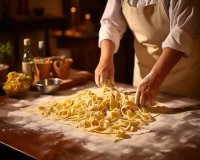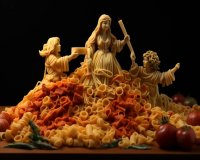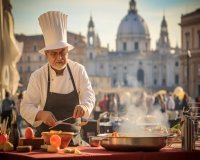Roman Culinary Essentials: What Every Aspiring Chef Should Know
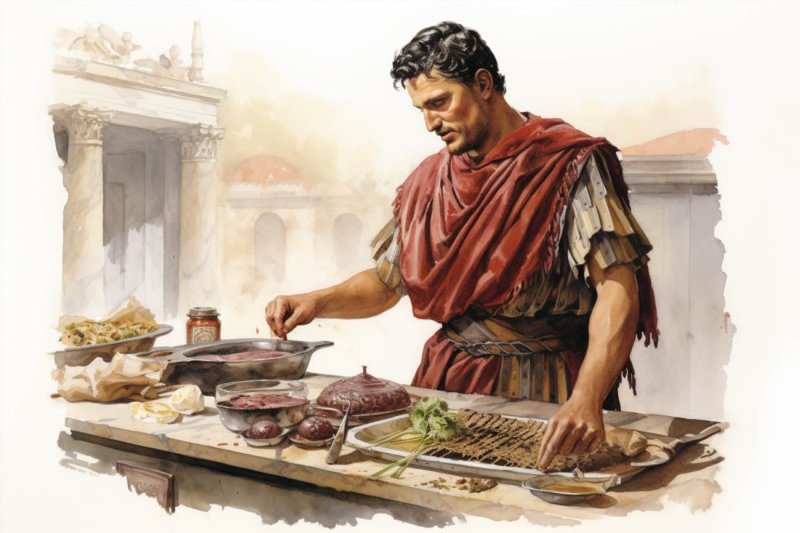
Roman Culinary Essentials: What Every Aspiring Chef Should Know
Rome, the eternal city, is not just famous for its ancient history and iconic landmarks but also for its rich and diverse culinary heritage. Roman cuisine is a delightful journey through flavors and traditions that have been perfected over centuries. If you're an aspiring chef looking to explore the world of Roman cooking, there are some key essentials you should know.
The Importance of Fresh Ingredients
One of the fundamental principles of Roman cuisine is the use of fresh, high-quality ingredients. Whether it's the ripest tomatoes, the freshest basil, or the finest olive oil, Romans prioritize the use of top-notch produce. This commitment to quality is what elevates their dishes to a level of excellence.
Pasta in All its Glory
Pasta is a staple in Roman cooking, and you'll find a variety of shapes and sizes in their dishes. From the classic Cacio e Pepe to the hearty Carbonara, mastering the art of pasta is essential for any Roman chef. Remember, the secret to a perfect pasta dish lies in the balance of ingredients and the simplicity of preparation.
Tradition Meets Innovation
Roman cuisine is a beautiful fusion of tradition and innovation. While classic dishes like Saltimbocca alla Romana or Supplì have been cherished for generations, contemporary chefs are adding their own twists to these recipes. Embrace the traditional, but don't be afraid to experiment and put your unique spin on Roman classics.
The Magic of Roman Street Food
When in Rome, you can't miss out on the delectable street food. Classics like pizza al taglio (pizza by the slice) and the unmistakable Roman Jewish-style artichokes are popular street food options. These quick, flavorful bites are an integral part of Roman culinary culture.
Wine: A Perfect Companion
Roman cuisine is best enjoyed with a glass of fine Italian wine. From a crisp Frascati to a robust Barolo, the wine selection in Rome is diverse and impressive. Understanding wine pairings can take your Roman culinary experience to the next level.
Respect for Seasonality
Romans have a deep respect for seasonality, and their dishes reflect the bounty of each season. Whether it's the fresh artichokes of spring or the hearty stews of winter, Roman chefs are experts at using what nature provides in the best way possible.
The Art of Simplicity
Roman cuisine is known for its simplicity. Dishes often have just a few key ingredients, allowing the natural flavors to shine through. This approach requires precision and a keen understanding of how different elements come together to create a harmonious dish.
Food Markets: Your Best Friend
If you want to experience the heart of Roman cuisine, visit the local food markets. Places like Campo de' Fiori and Testaccio Market are treasure troves of fresh produce, meats, and cheeses. Exploring these markets will give you a firsthand look at the ingredients that make Roman dishes extraordinary.
Endless Love for Cheese
Cheese is an integral part of Roman cooking. Pecorino Romano, a salty and sharp sheep's milk cheese, is a favorite in many traditional dishes. Whether grated over pasta or enjoyed on its own, Romans have a profound love for cheese.
Conclusion
Exploring Roman culinary essentials is a culinary journey that promises not only to tantalize your taste buds but also to deepen your understanding of the rich traditions and flavors that have shaped the eternal city. Remember, Rome's culinary heritage is as timeless as its monuments, and as an aspiring chef, delving into this world is a rewarding experience.
Rome: Combo Pizza and Pasta Cooking Class with Wine
Experience an authentic Italian pasta and pizza-making cooking class with a chef. Enjoy unlimited white and red wine, and taste Tiramisù and Limoncello for dessert, with transportation included.
About this activity
Free cancellation
Cancel up to 24 hours in advance for a full refund
Reserve now & pay later
Keep your travel plans flexible — book your spot and pay nothing today.
Covid-19 precautions
Special health and safety measures are in place. Check your activity voucher once you book for full details.
Highlights
Drink unlimited wine as you prepare and eat your own pizza and pasta
Make Neapolitan or Capricciosa pizza and cook it in a wood-fired oven
Learn how to make different pasta shapes (no machine required)
Enjoy an all-you-can-eat feast of pizza and pasta at the end of your cooking class
Taste authentic Tiramisù and sip on Italian Limoncello for dessert
Full description
Experience the most authentic way to enjoy food in Rome by making your own pizza and pasta with this cooking class. Go through all the steps, from preparing the dough to cooking in a wood-fired oven while enjoying unlimited wine. End your class with a tiramisù and Limoncello tasting.
Meet your guide and be transferred to the Wood Houses village where you will learn the art of Neapolitan-style pizza making and Italian Pasta. Sip on unlimited white and red wine as you learn from a local chef about Italian cooking. Next, make a Pizza Margherita or Capricciosa, and enjoy two different pasta dishes. Learn to make many different pasta shapes as you sip on Italian wine. For dessert, enjoy an authentic Italian tiramisù with Limoncello.
Finally, at the end of your experience, be brought back to the original meeting point with transportation included.
Includes
Round-trip transfers (with some exceptions)
Pasta cooking class
Pizza cooking class
Multilingual instructors
Tiramisù tasting
Limoncello tasting
Unlimited white and red wine
Hotel pickup and drop-off
all the drinks in the fridges (extra charge)
Meeting point
Meet your guide at metro stop Laurentina. At the exit you will find one of the local partner's staff with a cooking class sign.
Important information
Know before you go
The minimum drinking age is 18 years old
Infants up to 2 years can go for free (but they need to be booked for the transportation count and they have to sit on the legs of the parents)
The minimum age is 3 years old to take part in the class
Confirmation will be received at the time of booking
History of Ancient Roman Cuisine
Ancient Rome, one of the most powerful and influential civilizations in history, also had a rich culinary tradition that played a significant role in its society. The history of ancient Roman cuisine is a fascinating journey through time, reflecting the culture, economy, and daily life of the people who lived in the heart of the Roman Empire.
Culinary Influences
Roman cuisine was heavily influenced by the cultures it encountered as the empire expanded. The early Romans borrowed heavily from the ancient Greeks, incorporating their culinary techniques and recipes. As trade routes expanded, spices and exotic ingredients from Egypt, Persia, and other parts of the world found their way into Roman kitchens, adding depth and variety to their dishes.
Ingredients and Staples
Common staples of ancient Roman cuisine included grains such as wheat, barley, and millet. These grains were used to make various types of bread, porridge, and pasta. Romans were also fond of legumes like lentils and chickpeas, which were often used in soups and stews.
Meat, especially pork, was a significant part of the Roman diet. They also consumed beef, lamb, and game meat such as venison. Fish, available in abundance due to the empire's extensive coastline, was a popular choice, and various methods of preservation, including salting and drying, were employed to ensure a steady supply.
Cooking Techniques
Ancient Romans were skilled cooks, and they used a variety of cooking techniques to prepare their meals. Roasting, boiling, baking, and frying were common methods employed in their kitchens. They also used sauces and seasonings to enhance the flavors of their dishes.
Wine and Dining
Wine held a special place in Roman society and was an integral part of their meals. The Romans produced a wide array of wines, ranging from everyday varieties to fine vintages reserved for special occasions. Wine was often diluted with water and flavored with herbs and spices.
As for dining, the wealthy Romans enjoyed elaborate banquets featuring multiple courses and a diverse range of dishes. These feasts were a display of social status and often included entertainment such as music, dancing, and poetry recitals.
Legacy and Influence
The legacy of ancient Roman cuisine can still be felt today. Many modern Italian dishes trace their roots back to ancient Roman recipes. Pasta, for example, has evolved from the similar ancient Roman dish "lagana." Additionally, the concept of using sauces to enhance the taste of food, a prominent feature in Roman cooking, is a fundamental aspect of many cuisines around the world.
In conclusion, the history of ancient Roman cuisine is a testament to the ingenuity and creativity of the people of that era. Their culinary innovations and techniques have left an indelible mark on the world of food, shaping the way we eat and enjoy meals today.
Here, you'll find a unique opportunity to learn the art of crafting authentic Italian pasta at home, guided by local chefs. Immerse yourself in this hands-on experience in the heart of Rome's Piazza Navona, all while savoring complimentary bruschetta and drinks.
Recipes and Techniques of Roman Cooking in Rome
Roman cuisine is a rich tapestry of flavors, history, and traditions that have withstood the test of time. When you think of Roman cooking, you might conjure images of pasta, pizza, and gelato, but there's so much more to this ancient culinary culture. Let's delve into the recipes and techniques of Roman cooking in the heart of Rome.
One of the most iconic dishes of Roman cuisine is Cacio e Pepe. This simple yet delicious pasta dish features only three main ingredients: pasta, Pecorino Romano cheese, and black pepper. The key to a perfect Cacio e Pepe is in the technique. The pasta must be cooked al dente, and the cheese and pepper are emulsified with pasta water to create a creamy sauce.
Moving beyond pasta, let's explore another Roman classic: Saltimbocca alla Romana. This dish showcases the Romans' skill in working with veal. Thin slices of veal are wrapped in prosciutto, topped with sage leaves, and then sautéed in white wine and butter. The result is a tender and flavorful medley of tastes and textures.
Supplì, a beloved Roman street food, is essentially a deep-fried rice ball. These delightful morsels are made by forming leftover risotto into small balls, stuffing them with mozzarella cheese, breading them, and then frying until golden and crispy. The gooey cheese inside contrasts beautifully with the crunchy exterior.
The Role of Ingredients
Now, let's talk about the ingredients that define Roman cooking. Roman cuisine is deeply rooted in simplicity and the use of high-quality, local products. The use of Pecorino Romano cheese is a prime example. This sharp, salty cheese is a cornerstone of many Roman dishes, lending a distinctive flavor that's impossible to replicate with other cheeses.
The importance of olive oil cannot be overstated. Roman cooking relies heavily on extra virgin olive oil, which not only adds flavor but also acts as a cooking medium. It's used for sautéing, frying, and drizzling over finished dishes. The use of fresh, locally sourced vegetables, like artichokes and fava beans, also plays a central role in Roman cuisine.
Traditional Techniques
Roman cooking techniques are characterized by their simplicity and respect for the natural flavors of the ingredients. Braising and slow-cooking are common methods used to prepare meat dishes, resulting in tender and flavorful results. Additionally, grilling is popular, especially for lamb, which is seasoned with herbs and olive oil for a smoky, aromatic taste.
The art of making pasta from scratch is another cherished tradition. Romans take pride in creating their pasta, including classics like fettuccine, pappardelle, and, of course, the ever-popular spaghetti. The pasta dough is usually made with semolina flour and water, rolled out thin, and cut into various shapes, ensuring a fresh and delightful texture.
Conclusion
Roman cooking is a celebration of history, culture, and simplicity. It's a cuisine that has been perfected over centuries, showcasing the art of transforming humble ingredients into extraordinary dishes. Whether you're savoring a plate of Cacio e Pepe in a Roman trattoria or trying your hand at making supplì at home, the recipes and techniques of Roman cooking are a testament to the enduring appeal of this ancient culinary tradition.


